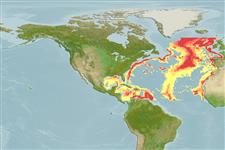Elasmobranchii (tubarões e raias) (sharks and rays) >
Rajiformes (Skates and rays) >
Rajidae (Skates)
Etymology: Rajella: Latin, raja, -ae = a sting ray (Raja sp.) (Ref. 45335).
Eponymy: Dr Henry Bryant Bigelow (1879–1967) was an American zoologist. [...] (Ref. 128868), visit book page.
Environment: milieu / climate zone / intervalo de profundidade / distribution range
Ecologia
marinhas batidemersal; intervalo de profundidade 650 - 4156 m (Ref. 4426), usually 1500 - ? m (Ref. 3167). Deep-water; 60°N - 10°N
Eastern Atlantic: Rockall Trough along Ireland, northern Bay of Biscay, northern Morocco and Azores, off Rio de Oro (Western Sahara) and Conakry (Guinea). Western Atlantic: Grand Banks off Newfoundland, Canada southward to northeastern Gulf of Mexico. Distribution probably much wider in deep water.
Tamanho / Peso / Idade
Maturidade: Lm ? range ? - ? cm
Max length : 55.0 cm TL macho/indeterminado; (Ref. 4426)
Found on continental slopes and deepwater rises (Ref. 3167). Oviparous. Distinct pairing with embrace. Young may tend to follow large objects, such as their mother (Ref. 205). Eggs are oblong capsules with stiff pointed horns at the corners deposited in sandy or muddy flats (Ref. 205). Egg capsules are 5.3 cm long and 3.0 cm wide (Ref. 41249).
Life cycle and mating behavior
Maturidade | Reprodução | Desova | Ovos | Fecundidade | Larvas
Oviparous (Ref. 3167). Paired eggs are laid. Embryos feed solely on yolk (Ref. 50449). Distinct pairing with embrace. Young may tend to follow large objects, such as their mother (Ref. 205).
McEachran, J.D. and K.A. Dunn, 1998. Phylogenetic analysis of skates, a morphologically conservative clade of elasmobranchs (Chondrichthyes: Rajidae). Copeia 1998(2):271-290. (Ref. 27314)
Categoria na Lista Vermelha da IUCN (Ref. 130435: Version 2025-1)
Ameaça para o homem
Harmless
Utilização humana
Pescarias: bycatch
Ferramentas
Relatórios especiais
Descarregue XML
Fontes da internet
Estimates based on models
Preferred temperature (Ref.
123201): 3.3 - 5.2, mean 3.9 °C (based on 389 cells).
Phylogenetic diversity index (Ref.
82804): PD
50 = 0.5000 [Uniqueness, from 0.5 = low to 2.0 = high].
Bayesian length-weight: a=0.00302 (0.00141 - 0.00645), b=3.24 (3.07 - 3.41), in cm total length, based on LWR estimates for this (Sub)family-body shape (Ref.
93245).
Nível Trófico (Ref.
69278): 3.6 ±0.5 se; based on size and trophs of closest relatives
Resiliência (Ref.
120179): Baixo, tempo mínimo de duplicação da população 4,5 - 14 anos (Fec assumed to be <100).
Fishing Vulnerability (Ref.
59153): Moderate vulnerability (42 of 100).
🛈
Nutrients (Ref.
124155): Calcium = 5.55 [0.81, 110.64] mg/100g; Iron = 0.332 [0.031, 4.526] mg/100g; Protein = 15 [13, 17] %; Omega3 = 0.536 [0.211, 1.385] g/100g; Selenium = 20.2 [3.3, 98.8] μg/100g; VitaminA = 4.85 [0.35, 64.69] μg/100g; Zinc = 0.307 [0.021, 3.539] mg/100g (wet weight);
